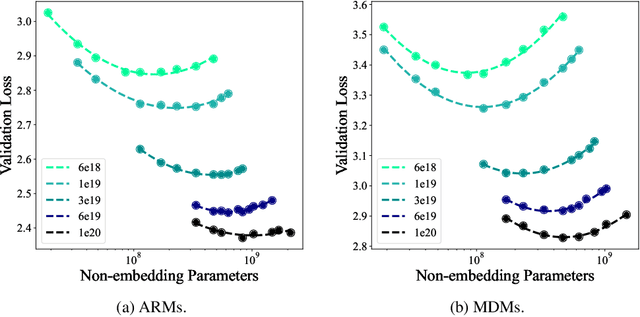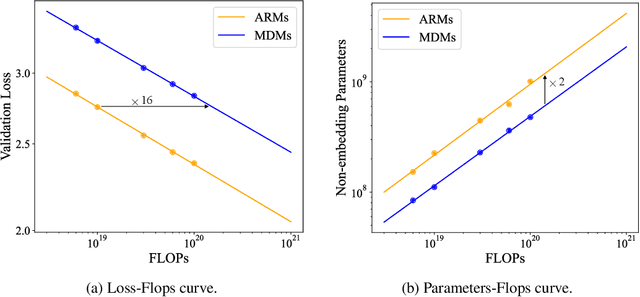Chao Du
Understanding R1-Zero-Like Training: A Critical Perspective
Mar 26, 2025Abstract:DeepSeek-R1-Zero has shown that reinforcement learning (RL) at scale can directly enhance the reasoning capabilities of LLMs without supervised fine-tuning. In this work, we critically examine R1-Zero-like training by analyzing its two core components: base models and RL. We investigate a wide range of base models, including DeepSeek-V3-Base, to understand how pretraining characteristics influence RL performance. Our analysis reveals that DeepSeek-V3-Base already exhibit ''Aha moment'', while Qwen2.5 base models demonstrate strong reasoning capabilities even without prompt templates, suggesting potential pretraining biases. Additionally, we identify an optimization bias in Group Relative Policy Optimization (GRPO), which artificially increases response length (especially for incorrect outputs) during training. To address this, we introduce Dr. GRPO, an unbiased optimization method that improves token efficiency while maintaining reasoning performance. Leveraging these insights, we present a minimalist R1-Zero recipe that achieves 43.3% accuracy on AIME 2024 with a 7B base model, establishing a new state-of-the-art. Our code is available at https://github.com/sail-sg/understand-r1-zero.
LongSpec: Long-Context Speculative Decoding with Efficient Drafting and Verification
Feb 24, 2025Abstract:Speculative decoding has become a promising technique to mitigate the high inference latency of autoregressive decoding in Large Language Models (LLMs). Despite its promise, the effective application of speculative decoding in LLMs still confronts three key challenges: the increasing memory demands of the draft model, the distribution shift between the short-training corpora and long-context inference, and inefficiencies in attention implementation. In this work, we enhance the performance of speculative decoding in long-context settings by addressing these challenges. First, we propose a memory-efficient draft model with a constant-sized Key-Value (KV) cache. Second, we introduce novel position indices for short-training data, enabling seamless adaptation from short-context training to long-context inference. Finally, we present an innovative attention aggregation method that combines fast implementations for prefix computation with standard attention for tree mask handling, effectively resolving the latency and memory inefficiencies of tree decoding. Our approach achieves strong results on various long-context tasks, including repository-level code completion, long-context summarization, and o1-like long reasoning tasks, demonstrating significant improvements in latency reduction. The code is available at https://github.com/sail-sg/LongSpec.
Sailor2: Sailing in South-East Asia with Inclusive Multilingual LLMs
Feb 18, 2025Abstract:Sailor2 is a family of cutting-edge multilingual language models for South-East Asian (SEA) languages, available in 1B, 8B, and 20B sizes to suit diverse applications. Building on Qwen2.5, Sailor2 undergoes continuous pre-training on 500B tokens (400B SEA-specific and 100B replay tokens) to support 13 SEA languages while retaining proficiency in Chinese and English. Sailor2-20B model achieves a 50-50 win rate against GPT-4o across SEA languages. We also deliver a comprehensive cookbook on how to develop the multilingual model in an efficient manner, including five key aspects: data curation, pre-training, post-training, model customization and evaluation. We hope that Sailor2 model (Apache 2.0 license) will drive language development in the SEA region, and Sailor2 cookbook will inspire researchers to build more inclusive LLMs for other under-served languages.
Improving Your Model Ranking on Chatbot Arena by Vote Rigging
Jan 29, 2025Abstract:Chatbot Arena is a popular platform for evaluating LLMs by pairwise battles, where users vote for their preferred response from two randomly sampled anonymous models. While Chatbot Arena is widely regarded as a reliable LLM ranking leaderboard, we show that crowdsourced voting can be rigged to improve (or decrease) the ranking of a target model $m_{t}$. We first introduce a straightforward target-only rigging strategy that focuses on new battles involving $m_{t}$, identifying it via watermarking or a binary classifier, and exclusively voting for $m_{t}$ wins. However, this strategy is practically inefficient because there are over $190$ models on Chatbot Arena and on average only about $1\%$ of new battles will involve $m_{t}$. To overcome this, we propose omnipresent rigging strategies, exploiting the Elo rating mechanism of Chatbot Arena that any new vote on a battle can influence the ranking of the target model $m_{t}$, even if $m_{t}$ is not directly involved in the battle. We conduct experiments on around $1.7$ million historical votes from the Chatbot Arena Notebook, showing that omnipresent rigging strategies can improve model rankings by rigging only hundreds of new votes. While we have evaluated several defense mechanisms, our findings highlight the importance of continued efforts to prevent vote rigging. Our code is available at https://github.com/sail-sg/Rigging-ChatbotArena.
Orient Anything: Learning Robust Object Orientation Estimation from Rendering 3D Models
Dec 24, 2024Abstract:Orientation is a key attribute of objects, crucial for understanding their spatial pose and arrangement in images. However, practical solutions for accurate orientation estimation from a single image remain underexplored. In this work, we introduce Orient Anything, the first expert and foundational model designed to estimate object orientation in a single- and free-view image. Due to the scarcity of labeled data, we propose extracting knowledge from the 3D world. By developing a pipeline to annotate the front face of 3D objects and render images from random views, we collect 2M images with precise orientation annotations. To fully leverage the dataset, we design a robust training objective that models the 3D orientation as probability distributions of three angles and predicts the object orientation by fitting these distributions. Besides, we employ several strategies to improve synthetic-to-real transfer. Our model achieves state-of-the-art orientation estimation accuracy in both rendered and real images and exhibits impressive zero-shot ability in various scenarios. More importantly, our model enhances many applications, such as comprehension and generation of complex spatial concepts and 3D object pose adjustment.
Real-time Identity Defenses against Malicious Personalization of Diffusion Models
Dec 13, 2024Abstract:Personalized diffusion models, capable of synthesizing highly realistic images based on a few reference portraits, pose substantial social, ethical, and legal risks by enabling identity replication. Existing defense mechanisms rely on computationally intensive adversarial perturbations tailored to individual images, rendering them impractical for real-world deployment. This study introduces Real-time Identity Defender (RID), a neural network designed to generate adversarial perturbations through a single forward pass, bypassing the need for image-specific optimization. RID achieves unprecedented efficiency, with defense times as low as 0.12 seconds on a single GPU (4,400 times faster than leading methods) and 1.1 seconds per image on a standard Intel i9 CPU, making it suitable for edge devices such as smartphones. Despite its efficiency, RID matches state-of-the-art performance across visual and quantitative benchmarks, effectively mitigating identity replication risks. Our analysis reveals that RID's perturbations mimic the efficacy of traditional defenses while exhibiting properties distinct from natural noise, such as Gaussian perturbations. To enhance robustness, we extend RID into an ensemble framework that integrates multiple pre-trained text-to-image diffusion models, ensuring resilience against black-box attacks and post-processing techniques, including JPEG compression and diffusion-based purification.
When Precision Meets Position: BFloat16 Breaks Down RoPE in Long-Context Training
Nov 20, 2024



Abstract:Extending context window sizes allows large language models (LLMs) to process longer sequences and handle more complex tasks. Rotary Positional Embedding (RoPE) has become the de facto standard due to its relative positional encoding properties that benefit long-context training. However, we observe that using RoPE with BFloat16 format results in numerical issues, causing it to deviate from its intended relative positional encoding, especially in long-context scenarios. This issue arises from BFloat16's limited precision and accumulates as context length increases, with the first token contributing significantly to this problem. To address this, we develop AnchorAttention, a plug-and-play attention method that alleviates numerical issues caused by BFloat16, improves long-context capabilities, and speeds up training. AnchorAttention reduces unnecessary attention computations, maintains semantic coherence, and boosts computational efficiency by treating the first token as a shared anchor with a consistent position ID, making it visible to all documents within the training context. Experiments on three types of LLMs demonstrate that AnchorAttention significantly improves long-context performance and reduces training time by over 50\% compared to standard full attention mechanisms, while preserving the original LLM's capabilities on general tasks. Our code is available at https://github.com/haonan3/AnchorContext.
Sample-Efficient Alignment for LLMs
Nov 03, 2024



Abstract:We study methods for efficiently aligning large language models (LLMs) with human preferences given budgeted online feedback. We first formulate the LLM alignment problem in the frame of contextual dueling bandits. This formulation, subsuming recent paradigms such as online RLHF and online DPO, inherently quests for sample-efficient algorithms that incorporate online active exploration. Leveraging insights from bandit theory, we introduce a unified algorithm based on Thompson sampling and highlight its applications in two distinct LLM alignment scenarios. The practical agent that efficiently implements this algorithm, named SEA (Sample-Efficient Alignment), is empirically validated through extensive experiments across three model scales (1B, 2.8B, 6.9B) and three preference learning algorithms (DPO, IPO, SLiC). The results demonstrate that SEA achieves highly sample-efficient alignment with oracle's preferences, outperforming recent active exploration methods for LLMs. Additionally, we release the implementation of SEA together with an efficient codebase designed for online alignment of LLMs, aiming to accelerate future research in this field.
Scaling up Masked Diffusion Models on Text
Oct 24, 2024



Abstract:Masked diffusion models (MDMs) have shown promise in language modeling, yet their scalability and effectiveness in core language tasks, such as text generation and language understanding, remain underexplored. This paper establishes the first scaling law for MDMs, demonstrating a scaling rate comparable to autoregressive models (ARMs) and a relatively small compute gap. Motivated by their scalability, we train a family of MDMs with up to 1.1 billion (B) parameters to systematically evaluate their performance against ARMs of comparable or larger sizes. Fully leveraging the probabilistic formulation of MDMs, we propose a simple yet effective \emph{unsupervised classifier-free guidance} that effectively exploits large-scale unpaired data, boosting performance for conditional inference. In language understanding, a 1.1B MDM shows competitive results, outperforming the larger 1.5B GPT-2 model on four out of eight zero-shot benchmarks. In text generation, MDMs provide a flexible trade-off compared to ARMs utilizing KV-cache: MDMs match the performance of ARMs while being 1.4 times faster, or achieve higher quality than ARMs at a higher computational cost. Moreover, MDMs address challenging tasks for ARMs by effectively handling bidirectional reasoning and adapting to temporal shifts in data. Notably, a 1.1B MDM breaks the \emph{reverse curse} encountered by much larger ARMs with significantly more data and computation, such as Llama-2 (13B) and GPT-3 (175B). Our code is available at \url{https://github.com/ML-GSAI/SMDM}.
SimLayerKV: A Simple Framework for Layer-Level KV Cache Reduction
Oct 17, 2024



Abstract:Recent advancements in large language models (LLMs) have extended their capabilities to handle long contexts. However, increasing the number of model layers and the length of input sequences significantly escalates the memory required to store key-value (KV) cache, posing challenges for efficient inference. To mitigate this issue, we present SimLayerKV, a simple yet effective method that reduces inter-layer KV cache redundancies by selectively dropping cache in identified lazy layers. Our approach is based on the observation that certain layers in long-context LLMs exhibit "lazy" behavior, contributing less to modeling long-range dependencies compared to non-lazy layers. By analyzing attention weight patterns, we find that the behavior of these lazy layers is consistent across tokens during generation for a given input. This insight motivates our SimLayerKV, which identifies lazy layers and reduces their KV cache accordingly. SimLayerKV is training-free, generalizable, and can be implemented with only seven lines of code. We conduct extensive experiments on three representative LLMs, e.g., LLaMA2-7B, LLaMA3-8B, and Mistral-7B across 16 tasks from the LongBench benchmark. The results demonstrate that SimLayerKV achieves a KV cache compression ratio of 5$\times$ with only a 1.2% performance drop when combined with 4-bit quantization. Our code is available at https://github.com/sail-sg/SimLayerKV.
 Add to Chrome
Add to Chrome Add to Firefox
Add to Firefox Add to Edge
Add to Edge